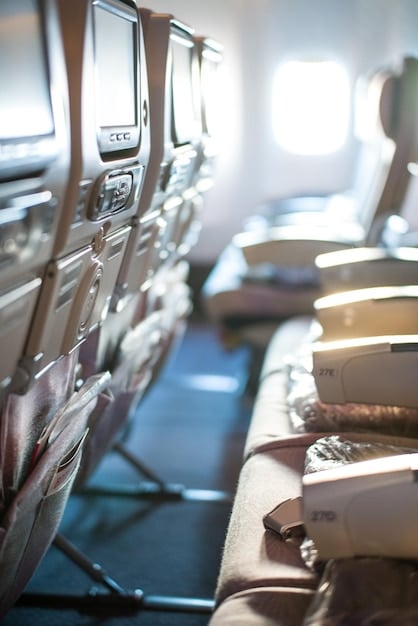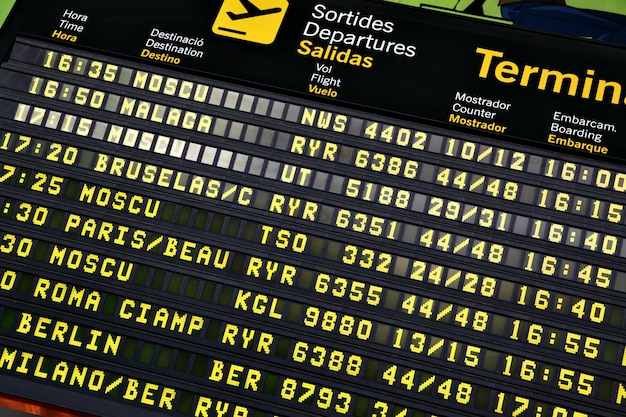Decoding Airline Seating Charts: Find Your Best Seat in 2025

Decoding airline seating charts is crucial for travelers aiming to enhance their flight experience by selecting the most comfortable and convenient seats, considering factors like legroom, proximity to amenities, and minimizing disturbances, ensuring a more enjoyable journey in 2025.
Navigating the world of airline seating charts can feel like deciphering a complex code. But with a little knowledge, you can transform your flying experience from cramped and uncomfortable to relaxed and enjoyable. This guide aims to provide you with the tools for decoding airline seating charts, ensuring you find the best seat every time, updated for 2025.
Understanding Airline Seating Charts
Airline seating charts are visual representations of the layout of seats inside an aircraft. They provide crucial information about the location of each seat, its features, and its proximity to amenities. Learning how to effectively read these charts is the first step towards securing the perfect seat for your flight.
Key Elements of a Seating Chart
Seating charts typically display the configuration of seats in rows and columns. Symbols and color-coding are used to convey different seat characteristics. Here are some essential elements to look out for:
- Seat Numbers: Each seat is assigned a unique number, usually consisting of a row number and a letter to indicate its position in the row (e.g., 1A, 2B, 3C).
- Seat Map Legend: Most charts include a legend that explains the symbols and colors used to represent different seat features, such as extra legroom or restricted recline.
- Amenities: Icons indicate the location of restrooms, galleys, and emergency exits.
Why Seating Charts Matter
Understanding seating charts allows you to make informed decisions based on your preferences. Whether you prioritize legroom, a window view, or proximity to the aisle, a seating chart provides the information you need to choose a seat that meets your specific needs. By decoding the chart, you can avoid unpleasant surprises like being seated next to the lavatory or in a cramped middle seat.

In conclusion, understanding airline seating charts is essential for any traveler looking to improve their flight experience. By familiarizing yourself with the key elements and interpreting the available information, you can make informed decisions and secure the best possible seat for your journey.
Factors to Consider When Choosing a Seat
Choosing the right seat is not just about avoiding the middle seat; it’s about aligning your seat selection with your personal preferences and needs. Consider these factors to ensure a comfortable and enjoyable flight.
Legroom and Seat Pitch
Legroom, also known as seat pitch, is the distance between a point on one seat and the same point on the seat in front of it. More legroom translates to greater comfort, especially on long flights. Look for seats in exit rows or bulkhead seats, which often offer extra legroom.
Window vs. Aisle Seat
The classic debate: window or aisle? Window seats offer a view and a wall to lean against, while aisle seats provide easy access to the restroom and allow you to stretch your legs without disturbing your neighbors. Your choice depends on your priorities.
Proximity to Amenities
Consider your proximity to restrooms, galleys, and emergency exits. Seats near restrooms may experience more foot traffic, while seats near galleys might be noisier. Exit row seats have restrictions, such as the inability to store items under the seat in front of you.
- Travel Time: For short flights, seat location has lesser impact; while for long haul flights it is crucial.
- Personal Needs: For passengers having special needs should prioritize seats with features/location suiting them.
- Budget: Seats with better legroom usually come at extra cost, so plan your budget.
Ultimately, the best seat is the one that aligns with your personal preferences and travel needs. By considering factors such as legroom, seat type, and proximity to amenities, you can make an informed decision and secure a seat that makes your flight as comfortable as possible.
Decoding Seat Maps: Expert Tips and Tricks
Decoding seat maps requires a keen eye and a bit of insider knowledge. Here are some expert tips and tricks to help you navigate the complexities of airline seating charts.
Using Online Tools and Resources
Several websites and apps offer detailed seat maps and reviews of specific aircraft. These tools often provide insights into which seats to avoid and which ones offer hidden benefits, such as slightly more legroom or a misaligned window.
Understanding SeatGuru and Other Review Sites
Websites like SeatGuru provide color-coded seat maps and user reviews, highlighting seats with potential drawbacks (e.g., limited recline, proximity to lavatories) and those with advantages (e.g., extra legroom, good window alignment). Checking these resources can help you avoid making a poor seat selection.
Avoiding Common Pitfalls
Be wary of seats near lavatories or galleys, which can be noisy and disruptive. Also, avoid seats with limited recline, often found in the last row of the cabin. Check reviews and seat maps carefully to identify and avoid these less desirable options.

Decoding seat maps can significantly enhance your flight experience. By using online tools, consulting review sites, and avoiding common pitfalls, you can navigate the complexities of airline seating charts and secure the best seat for your journey.
Specific Seats to Target for Comfort
While individual preferences vary, some seats are consistently ranked higher for comfort and convenience. Here are specific seats to target for a more enjoyable flight.
Exit Row Seats
Exit row seats offer significantly more legroom, making them a popular choice for taller travelers. However, be aware of the restrictions associated with these seats, such as the inability to store items under the seat in front of you and the requirement to assist in the event of an emergency.
Bulkhead Seats
Bulkhead seats are located at the front of a cabin section and offer extra legroom because there are no seats in front. These seats are also popular with families traveling with infants, as they often have attachments for bassinets.
Preferred Seats: What Airlines Offer
Many airlines offer preferred seats, which are standard seats in desirable locations, such as near the front of the cabin or with extra legroom. These seats typically come with an additional fee, but they can be worth the investment for enhanced comfort.
- Emergency situations: Exit row seats can improve access during emergency situations.
- Boarding/Deplaning: Front seats allows fliers to board and deplane faster.
- Sleeping: Window seats ensures uninterrupted sleep without the need of moving for other passengers.
Targeting specific seats known for their comfort and convenience can significantly improve your flight experience. Whether you prioritize legroom, ease of access, or a quiet environment, knowing which seats to look for can help you fly in comfort and style.
Leveraging Airline Policies
Airline policies can play a crucial role in securing your preferred seat. Understanding these policies and knowing how to leverage them can give you a competitive edge.
Early Check-In Strategies
Checking in early increases your chances of securing a better seat. Many airlines allow online check-in 24 hours before the flight, giving you a head start in the seat selection process. Set a reminder and check in as soon as possible to improve your odds.
Frequent Flyer Benefits
Frequent flyer programs often offer benefits such as priority seating and complimentary upgrades. If you’re a member of an airline’s loyalty program, be sure to take advantage of these perks to secure a more comfortable seat.
Special Assistance and Needs
If you have special needs, such as a disability or medical condition, airlines are often willing to accommodate your seating requests. Contact the airline in advance to discuss your needs and request a suitable seat.
Leveraging airline policies can significantly improve your chances of securing a preferred seat. From early check-in to frequent flyer benefits and special assistance, knowing how to navigate these policies can help you fly in greater comfort and convenience.
Future Trends in Airline Seating
The future of airline seating is evolving with advancements in technology and a greater focus on passenger comfort. Here are some trends to watch for in the coming years.
Customizable Seating Options
Airlines are exploring customizable seating options that allow passengers to tailor their seats to their specific needs. This could include adjustable legroom, reclining angles, and even modular seating arrangements that can be configured for couples or families.
Virtual Reality and In-Flight Entertainment
Virtual reality (VR) is poised to revolutionize in-flight entertainment, offering immersive experiences that can make even the longest flights more enjoyable. Some airlines are already experimenting with VR headsets that allow passengers to watch movies, play games, and explore virtual destinations.
Sustainable Seating Materials
As environmental concerns grow, airlines are increasingly adopting sustainable seating materials. This includes using recycled fabrics, lightweight composites, and bio-based materials to reduce the environmental impact of aircraft interiors.
- Passenger Experience: Improving the passenger experience via innovative designs and tech integrations.
- Ergonomics: Focusing seat ergonomics to reduce strain and improve comfort on long flights.
- Flexibility: Offering flexible seating arrangements to cater diverse passenger requirements.
The future of airline seating is bright, with innovations aimed at enhancing passenger comfort, entertainment, and sustainability. As these trends continue to develop, air travel will become an even more enjoyable and personalized experience.
| Key Point | Brief Description |
|---|---|
| 💺 Seat Maps | Essential tool to view seat layouts and amenities. |
| ✈️ Exit Rows | Offers extra legroom but may have restrictions. |
| 📱 Online Tools | Use SeatGuru to find reviews and best seats. |
| ⏰ Early Check-In | Improves seat selection options. |
Frequently Asked Questions
▼
Seat pitch is the distance between a point on one seat and the same point on the seat in front. More seat pitch means more legroom, enhancing comfort, especially during long flights. Always check the seat pitch before selecting your seat.
▼
You can use online tools like SeatGuru or consult the airline’s website. These resources often provide detailed seat maps, including information about seat pitch, width, and other features. This helps in making an informed decision.
▼
Exit row seats offer extra legroom but come with responsibilities and restrictions. Passengers must be willing to assist in an emergency and cannot store belongings under the seat. Ensure you meet these requirements before selecting an exit row seat.
▼
Contact the airline directly to discuss your special needs. Airlines are often willing to accommodate passengers with disabilities or medical conditions. Providing advance notice increases the chances of securing a suitable seat.
▼
Airline loyalty programs often provide priority seating, complimentary upgrades, and other perks. Frequent flyers should leverage their status to access these benefits, enhancing their chances of securing more comfortable and desirable seats.
Conclusion
Decoding airline seating charts involves a mix of strategy, awareness, and leveraging available resources. By understanding seat maps, considering your personal preferences, and utilizing airline policies, you can enhance your travel experience and secure the best seat possible. Embrace these tips to fly more comfortably in 2025 and beyond.





